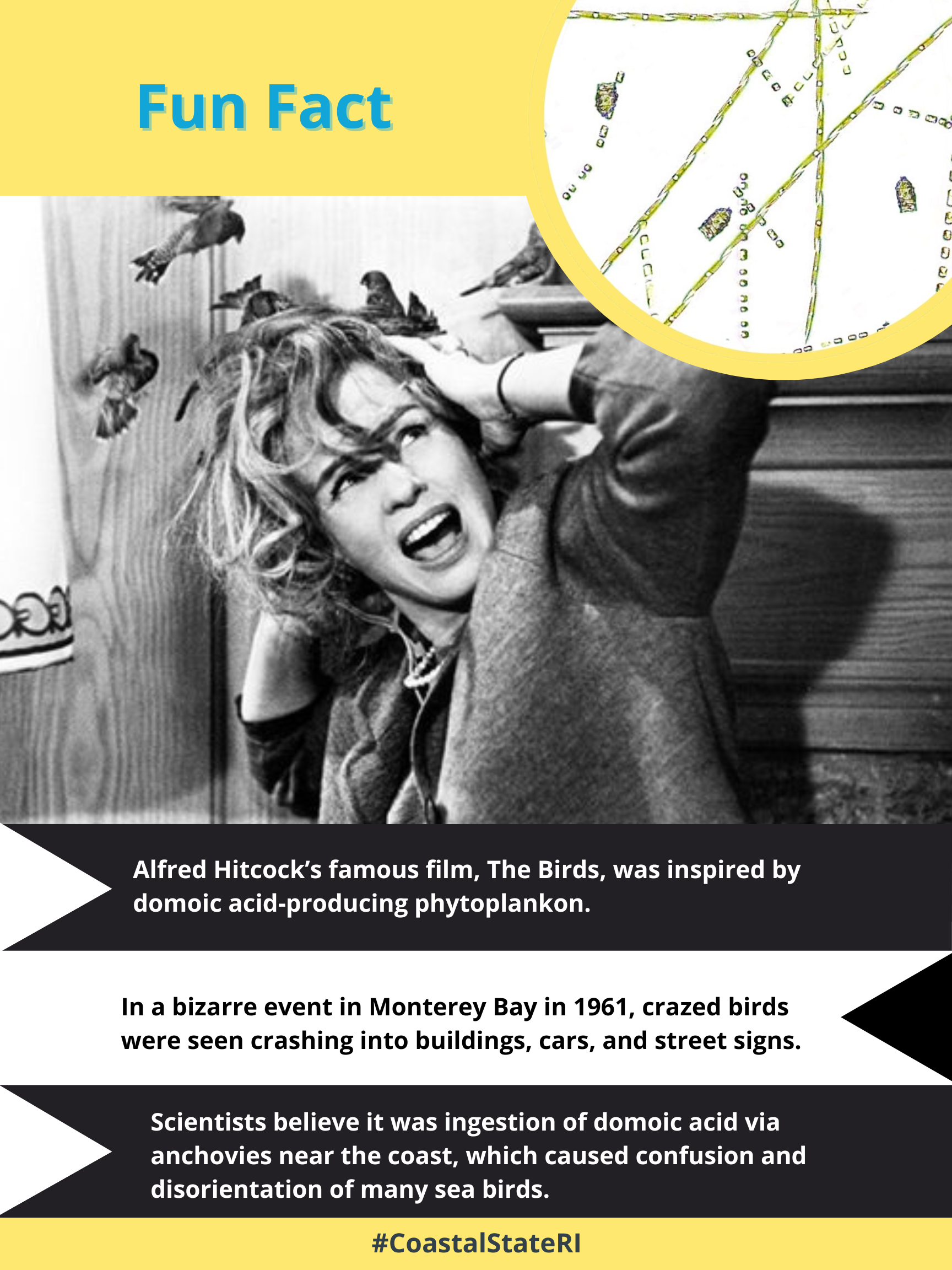New study finds that Narragansett Bay managers and shellfish harvesters should prepare for more severe harmful algal blooms in the future as changes in species composition and climate may increase favorable conditions for domoic acid production in Narragansett Bay and along the Northeast Atlantic.
By Meredith Haas
Certain plankton species of diatom phytoplankton can produce the neurotoxin domoic acid, which inspired the famous movie, The Birds, by Alfred Hitchcock
This neurotoxin can accumulate throughout the food web by shellfish and any other marine life that ingest phytoplankton. Ingestion in humans can be as severe as seizures and permanent short-term memory loss. It can also lead to confusion, disorientation, scratching, seizures, and death in marine life.
Even long-term exposure to low levels of domoic acid may be harmful, and events have far-reaching effects on communities, such as public panic and crippling losses in shellfish sales.
In 2016, high domoic acid levels spanned from Long Island to Maine, where nearly 5 tons of shellfish were recalled. In Rhode Island, a precautionary closure that lasted for 26 days was issued for Narragansett Bay due to elevated domoic acid numbers. It was the first and only bay-wide closure, although abundant Pseudo-nitzschia have been observed for over 60 years.
Recent findings from Sea Grant-supported researchers investigating environmental drivers of domoic acid production indicate species composition and domic acid production are linked to seasonal temperature changes and low nutrient availability.
The study revealed that domoic acid recurred in the fall and early summer, with the fall containing more known toxic Pseudo-nitzschia species, as well as a new genotype. These time periods were also associated with low dissovled nitrogen levels, further indicating the times of the year when domoic acid production is elevated and potentially a problem in Narragansett Bay.
Researchers also found that different Pseudo-nitzschia species were present in the 2016 shellfish closures and changed over time. P. australis, one of the most toxic Pseudo-nitzschia species that caused the 2016 bloom, was absent in Narragansett Bay and Massachusetts but was present in Maine and Canada. It wasn’t until 2017 that this species was present near the mouth of the bay and then found further up the bay in subsequent years – suggesting it was introduced from offshore.

“Thus, the Narragansett Bay closures were likely caused by both resident assemblages that become toxic depending on nutrient status as well as the episodic introductions of toxic species from oceanographic and climatic shifts,” according to the study published in the journal Limnology and Oceaongraphy.
Researchers from the University of Rhode Island conducted weekly samples at various sites within Narragansett Bay and offshore RI Sound and the Atlantic Ocean between 2017-2019 to compare links between the species found in the bay and those on the Northeast US Shelf.
Plankton species were identified using a new rDNA sequencing approach using molecular barcoding to better correlate environmental data and changes in species assemblages over time. To quanitfy plankton-asscoaited domoic acid, researchers used a mass spectrometry coupled with liquid chromatography (LC-MS/MS), which is not used by R.I. DEM in high frequency sampling but instead used as confirmation for other measurements. However, the application in this study allowed for rapid sampling and near real-time detection, allowing for a better understanding of toxin distribution at levels below closure concerns and deciphering toxin congeners.
“We have begun to predict their temporal patterns and magnitude from recurring patterns in this time series, which has potential implications for the larger region of the Atlantic Northeast. Ultimately, our results will inform forecasting [harmful algal bloom] models and management decisions of RI shellfish harvest,” stated in the study.
The study concludes that Narragansett Bay managers and shellfish harvesters should prepare for more severe harmful algal bloom events in the future as changes in the species composition and climate may increase favorable conditions for domoic acid production in Narragansett Bay and along the Northeast Atlantic.
Researchers note that more work is need to study other ecological factors that may drive certain species to grow and produce domoic acid. For examplle, greater domoic acid production in the fall could be the result of a unique Pseudo-nitzchia species composition distinct from spring/summer.
Other factors include pressure from grazing zooplankton or interactions with bacertial communities. With various elements at play, researchers still have yet to fully understand the ecological or evolutionary benefit of domoic acid production.
